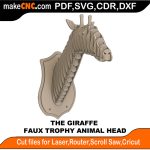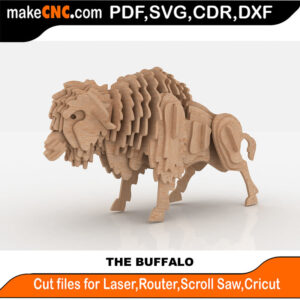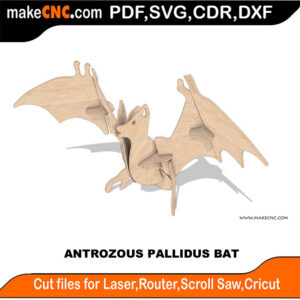The Rabbit : 3D Puzzle, Laser Cut, Scroll Saw, CNC Router, Template, Pattern DXF, CDR, SVG
$4.00
The Rabbit 3D Puzzle captures the adorable and iconic features of this small mammal in delightful detail. Designed as a laser-cut CNC template, this puzzle offers a rewarding and engaging assembly experience. Suitable for laser cutters, CNC routers, and plasma cutters. Included file formats are SVG, DXF, CDR, and PDF. Patterns are supplied in two standard sizes, usually 1/8th (.1250) and 3mm, but are scalable vectors, allowing you to adjust the pattern size to suit the thickness of your material. Scaling up will enlarge the finished model or shrink it if you scale down. Please see our Scale Calculator to make this task simple.
Description
PLEASE NOTE THIS IS A DIGITAL DOWNLOAD PRODUCT. NO PHYSICAL ITEM WILL BE SHIPPED !
The Rabbit
Rabbits are small mammals in the family Leporidae of the order Lagomorpha, found in several parts of the world. There are eight different genera in the family classified as rabbits, including the European rabbit, cottontail rabbits, and the Amami rabbit an endangered species on Amami Oshima, Japan. There are many other species of rabbit, and these, along with pikas and hares, make up the order Lagomorpha. The male is called a buck and the female is a doe; a young rabbit is a kitten or kit.
Rabbit habitats include meadows, woods, forests, grasslands, deserts and wetlands. Rabbits live in groups, and the best known species, the European rabbit, lives in underground burrows, or rabbit holes. A group of burrows is called a warren.
More than half the world’s rabbit population resides in North America. They are also native to southwestern Europe, Southeast Asia, Sumatra, some islands of Japan, and in parts of Africa and South America. They are not naturally found in most of Eurasia, where a number of species of hares are present. Rabbits first entered South America relatively recently, as part of the Great American Interchange. Much of the continent has just one species of rabbit, the tapeti, while most of South America’s southern cone is without rabbits. The European rabbit has been introduced to many places around the world.
Rabbits are hindgut digesters. This means that most of their digestion takes place in their large intestine and cecum. In rabbits the cecum is about 10 times bigger than the stomach and it along with the large intestine makes up roughly 40% of the rabbit’s digestive tract.
Rabbits are prey animals and are therefore constantly aware of their surroundings. For instances, in Mediterranean Europe, rabbits are the main prey of red foxes, badgers, and Iberian lynxes. If confronted by a potential threat, a rabbit may freeze and observe then warn others in the warren with powerful thumps on the ground. Rabbits have a remarkably wide field of vision, and a good deal of it is devoted to overhead scanning. They survive predation by burrowing, hopping away in a zig- zag motion, and, if captured, delivering powerful kicks with their hind legs. Their strong teeth allow them to eat and to bite in order to escape a struggle.
Rabbits are herbivores that feed by grazing on grass, forbs, and leafy weeds. In consequence, their diet contains large amounts of cellulose, which is hard to digest.
The most obvious difference between rabbits and hares is how their kits are born. Rabbits are altricial, having young that are born blind and hairless. In contrast, hares are born with hair and are able to see. All rabbits except cottontail rabbits live underground in burrows or warrens, while hares live in simple nests above the ground just like cottontail rabbits, and usually do not live in groups. Hares are generally larger than rabbits, with longer ears, larger and longer hind legs and have black markings on their fur. Hares have not been domesticated as of yet.
Rabbits may grunt, lunge and even bite. Usually they do not bite hard enough to break skin. Rabbits become aggressive when they feel threatened. This behavior can be corrected with the proper tools. House Rabbit Society says that the owner of the pet needs to win its trust, with certain behavioral tools.
Collect your unique Rabbit today!
Hello and Thanks for shopping with makeCNC!
These 3D Puzzles are a Downloadable Product that have been Designed ready to cut on any CNC router or CNC Laser Machine.
They are supplied as ready-to-cut vector files in several formats for CNC Routers, Lasers, Plasma, Die Cutters and Scroll Saws are just of the few ways you can use these Patterns.
Basic slot sizes (Meaning your Material Thickness)
1/8 Inch or 1/4 Inch
Metric: Slot Size (Meaning your Material Thickness)
3mm or 6mm
1 x Color Assembly Guide.
Number of Parts:
Finished size of Model at 1/8th or 1/4 Inch
Finished size of Model at 3mm or 6mm
Approximate Size at 3mm
L= 161
W = 51
H = 120
Approximate Size at 1/8 inch
L = 6.3
W = 2
H = 4.7
Approximate Size of Largest Part
2.4 X 4.3 inches
61 X 110 mm
Approximate Part Number: 42
NOTE: Our 3D Puzzles can be built in different thicknesses.
Example: 1/8″ uses 1/8″ Plywood…1/4″ uses 1/4″ Plywood, etc.
As a rule, although the slots are set to fit the same sized tool, most
people will use a smaller bit size when cutting on a CNC Router.
Copyright Policy
Respect Intellectual Property: At makeCNC, each of our digital patterns is a result of creativity and hard work. Unauthorized sharing, copying, or redistribution of our products not only violates legal boundaries but seriously impacts our community and ability to continue delivering new designs.
Current Policy: All downloadable products are copyrighted by makeCNC. Redistribution of these files in any format, other than material products made from the files, is strictly prohibited. Assembly PDFs can be sold as printed copies only alongside a finished product from the files.
Personal Use and Fair Use: You are encouraged to use our files to create as many physical items as you desire on your own machines. However, these rights are limited to personal use, not for third-party manufacturing.
Combat Piracy: We lose a significant portion of our annual income to piracy. You can help us by not participating in or encouraging the sharing or selling of our files. If you encounter makeCNC files being misused, please report them to us directly.
Legal Consequences: Engaging in piracy or unauthorized distribution of our files is not only damaging to makeCNC but is also a punishable offense under the law.
Thank You for Your Support: By adhering to this policy, you help makeCNC continue to thrive and innovate. We appreciate your understanding and cooperation.
Only logged in customers who have purchased this product may leave a review.








Reviews
There are no reviews yet.